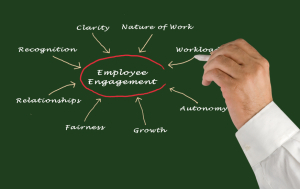Mary E. Marshall's Blog, page 38
November 6, 2014
Execution at Its Best
 An entrepreneur from last year’s Emerging Leaders class that I teach at the Small Business Administration experienced what most businesses would call “phenomenal growth.” He started by creating what he thought was a workable strategy to achieve the vision he had. The vision was good, but it was the same one he had for many years without much forward momentum towards achieving it. The company had experienced 5-8% growth, but they were barely meeting expenses and the owners were underpaying themselves. They had good people and good products and customers loved them, and still they struggled.
An entrepreneur from last year’s Emerging Leaders class that I teach at the Small Business Administration experienced what most businesses would call “phenomenal growth.” He started by creating what he thought was a workable strategy to achieve the vision he had. The vision was good, but it was the same one he had for many years without much forward momentum towards achieving it. The company had experienced 5-8% growth, but they were barely meeting expenses and the owners were underpaying themselves. They had good people and good products and customers loved them, and still they struggled.
About halfway through the class, the entrepreneur scrapped the entire plan and realized that several major issues or “big rocks,” kept getting in the way. The first item was a clear understanding of roles and what a future org chart would look like, including triggers for hiring. The second was the lack of good dashboards or metrics to measure anything. The last was a lack of a marketing strategy, which led them to take any business that came there way, without clear intention about the kind of business they wanted.
He went back to work and created an entirely new strategic plan, with strategic objectives and goals that made sense. He got the entire leadership team involved and everyone was ready to make it happen. Then he realized that a couple of players on the team needed to go. It became clear to him that if he wanted to do things differently, he needed to stop tolerating underperforming players. Once they were out of the way, the rest of the team started performing above expectations. It’s amazing what happens when you get people in the right seats, or get them off the bus entirely. It’s a game changer.
What I’m happy to report is that the three year strategic plan he created for 2014-17 will be complete as of December of 2014. (Let me be clear that I rarely see a plan work so well.) He is now in the process of creating a new plan as they need a new goal!
What made the difference for this company? Leadership and execution. Leadership to acknowledge what wasn’t working, make the changes necessary to get things on track, and provide the clear vision for the future. Once that was in place, execution of the three strategic priorities with appropriate smart goals was relatively easy. Execution is about continuous monitoring and improvement to make sure things are going according to plan and the willingness to change course when necessary. When we don’t check-in on things and see if we’re really meeting our expectations or goals, it’s about the equivalent of buying a lottery ticket. Keep checking, and most importantly, have the right metrics.
The willingness of this CEO to scrap his entire plan halfway through the class and create one that focused on the right “Big Rocks” made the difference between another mediocre year and a phenomenal year. It made a three year plan executable in one year. It’s the time of year for you to be looking at your plan. How did you do? If the answer is “I don’t know” or “not so well,” do a major change and start over. What have you got to lose?
The post Execution at Its Best appeared first on Mary Marshall // CEO Coach.
Strategy + Operations = Execution
 To have a strategy is one thing, to do something with it is something entirely different. My Emerging Leaders Class at the Small Business Administration just completed their 7 month course for entrepreneurs and I’m happy to say all 16 participants graduated with an executable strategy.
To have a strategy is one thing, to do something with it is something entirely different. My Emerging Leaders Class at the Small Business Administration just completed their 7 month course for entrepreneurs and I’m happy to say all 16 participants graduated with an executable strategy.
Now comes the hard part, the implementation or execution. Because of the way these plans were created all the graduates have a good shot at making them happen. The reason I believe they are likely to succeed is because the plans are based on 5 key components that I outline in Chapter 9 of my book. (Free download of chapter here). The components are:
Realistic Vision
Strategic Objectives (Big Rocks)
SMART Goals for each of the Strategic Objectives
Each of the SMART Goals has a person or team assigned as owner
The financial impact and measurement of each is defined
The Vision is the fun part, the execution – not so much – which is why some strategic plans never see the light of day. The company spends a ton of time and energy developing the plan, then “crickets” – nothing happens. So my philosophy is to make them easy and understandable and VERY executable.
Step one is to create the vision of where you want the company to be in 3 years. Next identify the gaps. What are the biggest gaps between where you are today and where you want to be tomorrow? Once you have Big Rocks or Strategic Objectives, you can craft a couple of specific goals (3-5) for each of them, assign an owner and figure out by when they will be complete and how to measure success.
What the entrepreneurs find is that once they have identified where they keep getting hung up and thus preventing growth, they are easily able to identify what needs to change or a strategy to bridge the gap. What happened with last year’s class, and is also happening with this year’s, is that once they determined the right strategic objective, execution seemed almost easy. They end up accomplishing the list of goals much, much sooner than they thought they would because they’ve identified the right gap and the right approach.
Next time you think about creating a strategic plan, think about it tactically as well. The execution of the right plan is the most important thing. Getting things done versus talking about them will make the most difference to your bottom line. Don’t make big overarching visions which lead to strategic objectives and goals that are unrealistic, even if you have all the resources. Craft the vision so that it is a stretch, but doable. Your team will have more faith in helping you achieve it if they can see a clear path. Your job is to be “the brush-clearer” and help remove obstacles so the path is laid out in front of your team.
Once the path is clear, execution accelerates and magic happens. If the plan is not workable, execution stalls and it stays on the shelf, or in the binder, and you get what you already have instead of the next level of growth and success.
The post Strategy + Operations = Execution appeared first on Mary Marshall // CEO Coach.
October 29, 2014
Are You Leading with Fear or Hope?
 One can’t help but read the headlines today and get a little depressed by all the fear that is being put out there. Whether it’s stories about Ebola, ISIS, elections, global warming or just about anything else that someone has an opinion on fear mongering seems to be the order of the day. We rarely see anything these days that is hopeful or celebrates all that is really quite good about our communities, our country, and our world.
One can’t help but read the headlines today and get a little depressed by all the fear that is being put out there. Whether it’s stories about Ebola, ISIS, elections, global warming or just about anything else that someone has an opinion on fear mongering seems to be the order of the day. We rarely see anything these days that is hopeful or celebrates all that is really quite good about our communities, our country, and our world.
Why is that? Bottom line, fear and hope are both motivators and fear tends to be more powerful because people are scared into protecting “what is” – what is theirs, what they believe, how things are and more. Hope on the other hand is asking you to believe in something that isn’t available today, rather to believe in what “could” be. We can’t touch or feel it yet so in order to believe we must have faith – in the idea, in the possibility, that’s it better than what “is,” and mostly, in leadership. Fear is easier to believe. Hope takes faith and faith is hard. Listen to any campaign on any side of the aisle and they are all talking “fear” – what you won’t have if you vote for the other candidate or initiative, not what you will have if you vote for them.
This is where true leadership can show up. It’s easy to scare people. Especially with 24/7 access to news in numerous channels from TV to social media, and with every outlet wanting so desperately to get the scoop that rumors and misinformation are spread like wildfire.
I had a woman tell me that Ebola was always fatal, that it’s airborne, and that she was keeping her kids home from school. I pointed out to her with documentation and resources that she was wrong on all counts. She was shocked and couldn’t believe what she “knew to be true” because she heard it on the radio actually wasn’t.
How do we lead with hope? President Obama did it in his first campaign for election quite successfully, painting a wonderful picture of who we are, how far we have come, and what is possible. I used it once to turn around a company as I needed everyone to believe that success was possible, even though I wasn’t so sure myself. It’s about envisioning a future that we can all share, and even if it’s a stretch, it’s close enough that we can believe it’s possible. It’s hopeful, not fearful. Every great leader has used hope in their leadership style to rally people to a common cause or goal. Lincoln told wonderful stories about what could be and always believed that things could be better. Jesus was a great example of a hope-based leadership style!
Think back to your best leadership moments and I’ll bet you’ll find you led with hope, not fear. Fear-based leadership is for small thinkers, for status quo, for protecting what “I” have. As you lead your teams, your companies, or your life, examine your leadership style. If you find yourself on the fear side more than hope, you might want to change the balance of power.
photo credit: Jimee, Jackie, Tom & Asha via photopin cc
The post Are You Leading with Fear or Hope? appeared first on Mary Marshall // CEO Coach.
October 22, 2014
Changing Your Mind is Not a Sign of Weakness
 “Faced with a choice between changing one’s mind and proving there is no need to do so, most everybody gets busy on the proof.” -John Kenneth Galbraith
“Faced with a choice between changing one’s mind and proving there is no need to do so, most everybody gets busy on the proof.” -John Kenneth Galbraith
I love this quote, because it’s spot on. We would rather spend hours defending our position than entertain the possibility of viewing things another way. Why is this? I think there are a couple of things going on. One piece has to do with the fact that people will only change when the pain of changing is less than the pain of staying the same. The other piece, which is particularly relevant to leaders, is the fear that if they change their minds, it implies they weren’t right in the first place and being wrong is often seen as a sign of weakness. No leader wants to appear to be weak.
Leaders are often put in positions where they have to make a choice between being partially right and most definitely wrong. To avoid the “wrong” they often punt the ball and make no choice, or go about finding proof that they are right and don’t need to change. But as I discussed last week, to be “right” automatically makes someone else wrong and that’s not helpful when you are leading a team. So let’s get rid of the right/wrong conversation and change the question to “what’s best for the situation?”
If you are afraid to be wrong it will almost ensure that you are not making the best decisions. So what does a leader do? They make the best judgment call they can given the facts available at the time, and are willing to course correct when it appears that whatever they decided is not working. The best mentors I’ve had were always ready, willing, and able to make a change whenever they felt the outcome was not working out as they wanted. No harm, no foul, just own it and move on to the next plan. Real success can only be built on failure because that is where you’ll find the most “data” and learning. Build your ability to accept being wrong and you’ll end up making much better decisions in the long run.
I think another reason why some leaders and politicians are so loath to change their minds is that they themselves become so closely identified with what they’ve declared, decided or said. It’s as if they’ve just written the declaration of independence or something equally as substantial – that what they’ve said or decided makes them who they are. It doesn’t. It’s just a statement, belief or opinion and there are plenty of others to counter it.
Humility is one of the qualities of great leaders according to Jim Collins of Good to Great fame. It enables them to make better decisions because their “ego” is not attached to outcomes. So, just for today, detach from the fear about decisions, be willing to change your mind, and know that each decision you make will get you closer to success, (even if a particular decision led to a failure). Remember my previous blog – Fail Fast and have some fun!
photo credit: bitznbitez ( was lucias_clay ) via photopin cc
The post Changing Your Mind is Not a Sign of Weakness appeared first on Mary Marshall // CEO Coach.
October 15, 2014
The Art of Compromise
 Compromise as a noun is described as an “agreement or a settlement of a dispute that is reached by each side making concessions – an ability to listen to two sides in a dispute, and devise a compromise acceptable to both.” As a verb it is “settle a dispute by mutual concession.” Nowadays it seems that people take the “my way or the highway” approach more often than not.
Compromise as a noun is described as an “agreement or a settlement of a dispute that is reached by each side making concessions – an ability to listen to two sides in a dispute, and devise a compromise acceptable to both.” As a verb it is “settle a dispute by mutual concession.” Nowadays it seems that people take the “my way or the highway” approach more often than not.
Why is it so important that we get our way? Is the art of compromise lost? As I was thinking about this, I was reminded of an incident this morning. I was driving on a residential street and a pedestrian entered a crosswalk in front of me, a man in his late 20s or early 30s. I stopped, (although there was no stop sign at this crosswalk), as pedestrians have the right of way. What I found annoying was that he never even glanced in either direction to see if traffic was coming, just assumed we would all stop for him. And this is not the first time I’ve seen this. In fact, over the past 5 years I think this is so commonplace I’m surprised there are not more injuries. The point is the sense of entitlement. The “I have the right of way, therefore you must stop” arrogance. As sound as this assumption might be, it really boggles my mind that one could be so absorbed as to think this is really how the world works.
I think it says a lot about why compromise is somewhat of a lost art. Walking across the street without checking to see that you are reasonably safe where traffic is involved is egocentric at the very least and unsafe at its worst. Is it merely all about each of us as individuals? Some think so. Just look at our deadlocked politicians who can’t get any laws passed because they are so set on their “point-of-view” that they refuse to see the other side and so nothing gets done. In these situations it’s difficult to understand why compromise could not solve the problem. I understand that where values are concerned, one usually will not make a change, but not taking any action can often make the situation worse.
If we separate what we believe and our ego, with what needs to get done, we can often see a path forward. From a leadership standpoint, this means going first and not waiting for someone else to offer up a solution. It involves finding out what is really important to the other side, what is non-negotiable and floating ideas for a middle ground. This requires discussion, listening, and questioning. Setting aside your “beliefs” about something for just a minute so that you might see things from another’s point-of-view. Abraham Lincoln was a master at compromise, as well as a great listener and storyteller. He knew that to be “right” meant that someone else was “wrong,” so he suspended judgment, listened, and found the middle ground that would serve the greater good and usually the majority.
Just for today, try letting go of the beliefs that keep you stuck and prevent you from seeing the other point-of-view. See if you can focus on the other perspective to achieve better solutions for long-term success. Just ask a few questions with genuine curiosity and you’ll be surprised at what you might discover. Compromise doesn’t have to be a lost art.
photo credit: Ken Whytock via photopin cc
The post The Art of Compromise appeared first on Mary Marshall // CEO Coach.
October 8, 2014
Engaged Employees? It’s Not About the Perks!
 In our quest to find the key to building great companies we look for the easiest and fastest solutions. The “solution du jour” seems to be CEOs trying to make employees happy by providing all sorts of perks. The not so surprising result is that perks are not what makes employees happy.
In our quest to find the key to building great companies we look for the easiest and fastest solutions. The “solution du jour” seems to be CEOs trying to make employees happy by providing all sorts of perks. The not so surprising result is that perks are not what makes employees happy.
There is a great interview with Jim Clifton, CEO of Gallup, about all their recent findings regarding “employee happiness.” What the research shows is what I’ve been talking about for years – it’s about having the employees in the right seats. Strengthfinders says that you can’t fix a weakness and I completely agree. It’s about identifying a person’s strengths and finding a fit for those with a job that utilizes them. Clifton says, “The idea of trying to make people happy at work is terrible.” Perks and free lunches do not drive employee engagement. Engagement can only come from being in a place where someone’s contribution is important, recognized, and where they are doing something they can do very well.
Clifton also talks about culture, which ultimately drives performance in an organization. He says about CEOs and Executive managers, “They’re beginning to recognize that an authentically caring culture provides a clear and sustainable competitive advantage.” The key here is authenticity. Employees can spot a phony a mile away and innately know when someone is being inauthentic. A few weeks ago I wrote about the millennials and what they wanted. One of the 5 most important things for them was to be competitively and intellectually challenged, another was to make a difference. What this means is that they want to work for and with people who CARE. Caring about them, their career, the company and their co-workers makes a very, very productive culture.
So how do you start? It all starts at the top, with the leader using their heart. When a leader cares, they get results. So what’s not to like about this solution? It’s not everyone’s cup of tea, and for some leaders, caring is a sign of weakness. The reality is that not only is it not weakness, I would call it a sign of strength.
Take a look at your workforce. Is everyone performing at their peak? Probably not. Look at the positions you have people in and see if the roles fit their strengths. If not, see if you can modify the job so that it does, or move them into a role that will. If you don’t have anything for them, the best gift that you can give them is to sit them down, have a conversation about who they are, what they want, and what you think they are good at, and help them find a job somewhere else.
The rest of your team will be thankful you were so caring, and also that you are reinforcing the culture of performance by only having the right people in the right seats on the right bus – remember Jim Collin’s “Good to Great?” It makes for a great, caring culture that produces results.
The post Engaged Employees? It’s Not About the Perks! appeared first on Mary Marshall // CEO Coach.
October 1, 2014
Leadership Puzzler: What Should Be Measured?
 One of my clients has been struggling with the dashboard question for a while. What to track? What makes a difference? In addition, he had a couple of partners whose interest in the “numbers” was less than enthusiastic and they simply wanted to get the work done. The CEO tried several versions without success, meaning that they didn’t really tell him anything about his business that was predictive. Meanwhile, sales just continued to bump along at a steady 5-7% growth rate, with the same challenges continuing to come around like clockwork. His partners could not understand why he was even looking at his dashboard since things were good in their minds. After a year of trying to find the right indicators, he was about to give up, when he had a thought that maybe he needed to find out what other people might want to see.
One of my clients has been struggling with the dashboard question for a while. What to track? What makes a difference? In addition, he had a couple of partners whose interest in the “numbers” was less than enthusiastic and they simply wanted to get the work done. The CEO tried several versions without success, meaning that they didn’t really tell him anything about his business that was predictive. Meanwhile, sales just continued to bump along at a steady 5-7% growth rate, with the same challenges continuing to come around like clockwork. His partners could not understand why he was even looking at his dashboard since things were good in their minds. After a year of trying to find the right indicators, he was about to give up, when he had a thought that maybe he needed to find out what other people might want to see.
So he sat each of his partners and senior managers down and asked what they looked at each month to tell them if they were on or off track. He was actually surprised at what he heard because a couple of the indicators were in the heads of his managers, but nowhere in his spreadsheets! His sales manager said he knew if the number of leads coming in during a given month were “X,” in two month’s time sales would be a multiple of that. The CEO had wondered if the money he spent on sales leads worked and here was his answer, so he started tracking sales leads and the ratio of closed sales to leads. As time went on, he started tracking the size of the sale and several other factors to see if he could find identifiers for the ideal customers.
He found similar insights in the conversations with the installation and engineering departments. Next, he had each leader create his own dashboard with his help and then aggregated them into a single one for the company. Now each of their senior staff meetings starts with an explanation of anything that is out of the ordinary on the dashboards, what they should do about it, and then on to new business. Meetings are never longer than an hour and the team leaves energized and feeling it was a productive meeting. Interestingly, their growth rate has increased to 15-18% on average over the last 12 months. I suppose there were several factors that led to this, and you can’t say it was just the dashboards, however, I believe it was about 95% of it. You can’t affect your productivity or sales levers without first knowing what they are.
photo credit: WingedWolf via photopin cc
The post Leadership Puzzler: What Should Be Measured? appeared first on Mary Marshall // CEO Coach.
What Makes a Good Dashboard?
 I get asked this question all the time, “what should my dashboard look like?” The answer is, it depends. Most dashboards should have the basic financial key indicators for your business, revenue, gross profit and net profit but those seldom tell the whole story. What really matters for your dashboard is what are your leading key indicators? What will tell you how you might do in the future?
I get asked this question all the time, “what should my dashboard look like?” The answer is, it depends. Most dashboards should have the basic financial key indicators for your business, revenue, gross profit and net profit but those seldom tell the whole story. What really matters for your dashboard is what are your leading key indicators? What will tell you how you might do in the future?
When I had my own business I tracked everything but could not predict how we would do in the future, except as a guess based on what we had done in previous years. Yet I knew that good businesses and good leaders were able to predict. My mentor at the time kept challenging me to dig for the right financial key indicators, not by looking at what had already happened, but looking at which metrics were predictive. I kept looking harder but still wasn’t seeing them. Then I came across Kraig Kramers’ CEO Toolkit which explained how to create trailing average charts. Aha! I was finally on to something. I took our numbers and created 3, 12 and 18 month trailing averages for the metrics that I tracked and finally saw trend lines. Instead of comparing how I did from one month to the next or the same period last year, I was able to see an actual trend!
From there I was able to identify the key indicators that were most important for my business at the time. In Chapter 8 of my book, (click link for *free* download), I have a list of possible Key Indicators for your business and all can be measured with trending 12, 18, and 36 month averages. It’s important not to get carried away with these as you can start tracking everything, (which will drive your financial team crazy and doesn’t really move the needle forward). Pick 2-4 key indicators that will tell you if your new initiatives are working, or things you’re working on are improving. These are in addition to your basic financial key indicators. Once you get a good handle on some of these variable indicators, such as Revenue per Employee perhaps, you can change it up and track something else that will have an impact on top or bottom line performance.
The key to success with a dashboard is succinct, specific, one page and regular. This means make time for the discipline to get it done, report out, and have your senior team use it to make decisions. With one quick glance, you should be able to see if you’re on track, against goal, or off. It’s not just a nice report, it should be a working tool. At CEO Global Network we require a dashboard of all of our members that they bring to each meeting. This gives the other group members a window into a company’s performance and creates a common language with which to help one another with their businesses.
Remember, flying a plane without a functional dashboard will not end well, neither will it be successful for your business.
The post What Makes a Good Dashboard? appeared first on Mary Marshall // CEO Coach.
September 24, 2014
Networking Made Simple
 As I was preparing a talk for the Washington State Biz Fair this Saturday, I realized that the idea of networking can be intimidating to a lot of people. When the topic of networking comes up generally there are long sighs. It can be people’s least favorite thing to do – myself included. However, we need to think about it differently. It’s really about making connections that will help you and your business, so what’s not to like?
As I was preparing a talk for the Washington State Biz Fair this Saturday, I realized that the idea of networking can be intimidating to a lot of people. When the topic of networking comes up generally there are long sighs. It can be people’s least favorite thing to do – myself included. However, we need to think about it differently. It’s really about making connections that will help you and your business, so what’s not to like?
The problem is that most of us are not good at it and not comfortable with it. I’ve been told I’m a good networker and that would be an accurate statement. What I can tell you is that up until a few years ago I didn’t like it much at all, but did it because I knew it was necessary. Networking is really making connections and meeting people who might be able to connect you to the people or things that you are seeking. It’s dating for business.
Why are we typically so bad at it? Let’s be honest, most of us don’t like going up to strangers and making chitchat. It’s awkward and in most cases, a bit of a waste of time. Because we dread it we don’t prepare, and guess what? The outcome we get is exactly what we expected, bupkis.
Let’s start with purpose, preparation and then some tactics to make this necessary venture more successful. First, identify the purpose of why you’re attending the event or gathering. What do you want as an outcome? What would make it worth your time? Once you’ve defined your purpose, then you need to make sure your elevator pitch is “pitch perfect.” Not a 2 minute ramble about you and your business, but a very short succinct message with name, business and one sentence about what your business does e.g. “we provide connections for architects and talent.” Short and sweet and to the point. The other preparation piece is your “ask.” What do you want? “I want connections to architectural firm leaders who need help finding talent.” Remember, it’s not going to be the person you are talking to, it’s going to be who they know, and so on. That’s networking. Casting a wider net that works for you.
Now that you have those two items defined, how do you start? It’s about asking the right questions. You want to make sure they are open ended vs. close ended, (meaning yes or no questions). “Do you have kids?” is a pretty hard stop when the answer is “no.” “What brought you here today?” doesn’t have a wrong answer and gets the conversation started. Other good starters:
Tell me about your business?
What are you hoping to find today?
Who were you hoping to meet?
Where are you originally from?
Remember, it’s about them, not you. You will get what you need after you build some trust with them.
The best advice I ever received for networking was to go to the person that is standing alone because they are likely as uncomfortable as you are. Don’t crowd into several people engaged in conversation, it’s annoying.
Once you’ve established rapport, then it’s time to ask for what you want. After that, thank them and offer to make an introduction or say you need to catch someone before they leave and move on. The event will fly by, you’ll have had a little fun, and you just may come away meeting your goal and having some valuable new connections for you and your business.
photo credit: MyTudut via photopin cc
The post Networking Made Simple appeared first on Mary Marshall // CEO Coach.
September 10, 2014
What Employees Want
 There was an interesting section in the Wall Street Journal this weekend about the Top Employers in the US. The section was paid advertising, so I don’t give the rankings much credence as it’s one of those pay to play “awards.” However, there was a good section about Millennials and what they want from an employer. As leaders of companies who will be employing them, we might want to take note.
There was an interesting section in the Wall Street Journal this weekend about the Top Employers in the US. The section was paid advertising, so I don’t give the rankings much credence as it’s one of those pay to play “awards.” However, there was a good section about Millennials and what they want from an employer. As leaders of companies who will be employing them, we might want to take note.
The article entitled, “Work/Life Balance” by Katherine Lynn discusses the “spoiled, lack of focus, entitled” beliefs we seem to have about this group. In fact, what she found according to a research project is that they really want five things:
To have work/life balance
To be secure/stable in my job
To be dedicated to a cause
To be competitively or intellectually challenged
To be entrepreneurial or creative/innovative
Now I have to say that when I read this list my first thought was, “well who doesn’t?” We all want these things. The problem is they don’t always come together in a nice neat package. Entrepreneurs can’t, and don’t, always offer stability or work/life balance. All jobs cannot be intellectually stimulating or the toilets would never be cleaned. Most companies have causes, they just might not always line up with what an individual’s beliefs are.
As a leader, what can you offer this generation? It’s really what you should be offering all employees. First, you can be clear about what working for your company means – what the responsibilities are, the growth opportunities, what you stand for, (the “why” of your company), and how much independence they will have or not in any given role. As much as many would like to go back to the old days of employment for life today is more about fit and performance vs. guarantees of lifetime employment. So it is what is. Let’s embrace it, realize it and be clear that you will not have employees forever. They will come, learn some things, hopefully move you and your company along in their mission while with you and then they will leave to the next opportunity.
We need to look at this through a new lens. Instead of viewing this as disloyal or costly, look at it as an opportunity to continually be upgrading your talent. Provide an excellent experience for them while they are with you that is mutually beneficial and when the end comes, because it will, part with grace. Wish them well and thank them for their contribution.
Lastly, you can provide all of the “desires” listed above to the right individual. This is the person whose value set is a match for your company. In addition, they come with the skills and experience that make it worth your while to invest in them. A good employee fit is ALWAYS mutual, so don’t forget to ask what’s important to them and share what’s important to you and your company. Expectations clearly defined at the start lead to a much longer and more profitable tenure for both parties.
The post What Employees Want appeared first on Mary Marshall // CEO Coach.



